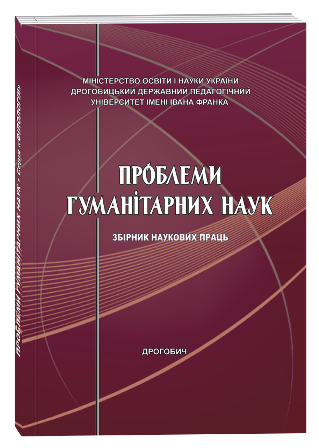LEXICAL CONNOTATION IN THE SPEECH CREATIVE ACTIVITY OF THE STUDENT
DOI:
https://doi.org/10.24919/2522-4565.2023.55.3Keywords:
semantic, stylistic functions, emotional and evaluative attitude of coloratives, zoonyms, phytonyms, symbolic words, phraseological unitsAbstract
The article examines the concept of connotation as a multifaceted phenomenon that has an additional shade, a component of meaning, a semantic modification, a process, a sign, a sign system, and a thought-language mechanism. The issue of lexical connotation in the linguistic culture of students, their knowledge of the status of connotation, its types, the limits of functioning and the ability to apply connotations in creative written works is revealed. The purpose of the work is to study the phenomenon of connotations in the written creative activity of high school students, the analysis of individual samples, comparison and use some permanent expressions in the Ukrainian language. To achieve the goal, the following tasks were solved: generalization of the theoretical aspects of the functioning of the concept of connotation; the essence of lexical connotation and its types in creative written works of students is revealed. In the analyzed works, we found the following types of connotations: coloratives, zoonyms, phytonyms. These types of connotations have great potential for linguistic and cultural comparisons. The analysis of the types of lexical connotation in its double meaning in the written creative activity of high school students showed that they are directly related to national culture, as it is formed in a certain national-linguistic environment, where the main factor affecting the semantic halo of a word is pragmatics those who communicate. Connotations perform cumulative, semantic or stylistic, emotional and evaluative functions of language. Connotations of coloratives contain information about the most persistent (subconscious) visual tastes of color perception, which are reproduced in the individual language of the speaker of this language, forming the mentality of the individual. Zoonyms and phytonyms are used to distinguish positive or negative qualities of a person, they are found as lexemes, word-symbols and phraseological units. The perspective of our further research is to reveal in more detail the emotional and evaluative attitude of the individual to the surrounding world, other people, to himself, which is manifested in the use of various types of connotation in the creative activities of students and is an important aspect of learning about national linguistic features.
References
Зайченко Ю. О. Конотація як лінгвістичне явище : дефініція, типологія, властивості та структура. Science and Education a New Dimension. Philology. 2019. VII(61). Issue 210. С. 81–85.
Іщенко Н. Г. Оцінний компонент лексичного значення слова. Філологічні трактати. Суми. 2010. № 3. С. 47–50.
Кияк Т. Р. Мотивованість лексичних одиниць (Кількісні та якісні характеристики). Львів : Вища школа, 1988. 164 с.
Конотація. Редактор Оксана Гришко. URL : https://bigbro.com.ua/shho-take-konotatsiya-ponyattya-funktsiyi-vislovlennya-otsinochnih-emotsij-i-prikladi/.
Манакін В. М. Мова і міжкультурна комунікація : навчальний посібник. Київ : ВЦ «Академія», 2012. 288 с.
Марчук О. В. Конотативний простір світу англомовного фентезі. Науковий вісник Міжнародного гуманітарного університету. Сер. : «Філологія». 2015. № 19. Т. 1. С. 95–97.
Селіванова О. О. Сучасна лінгвістика : термінологічна енциклопедія. Полтава : Довкілля-К, 2006. 716 с.
Туріщева О. О. Історія перекладу Дж. Кетфорда. Конспект лекцій для студентів напр. філологія. Київ : НТУІ (КПІ), 2015. 48 с.
Di Pietro R. J. Language Structures in Contrast. Massachusetts : Newbury House Publishers. 1971. 193 p.
Fartakh A. La connotación y la idiosincrasia lingüística y cultural : (asociaciones semántico-léxicas en el español de Granada y en el árabe de Tetuán, Marruecos) : tesis doctoral de Filología Hispánica. Granada : Universidadde Granada, 1998. 369 p.



